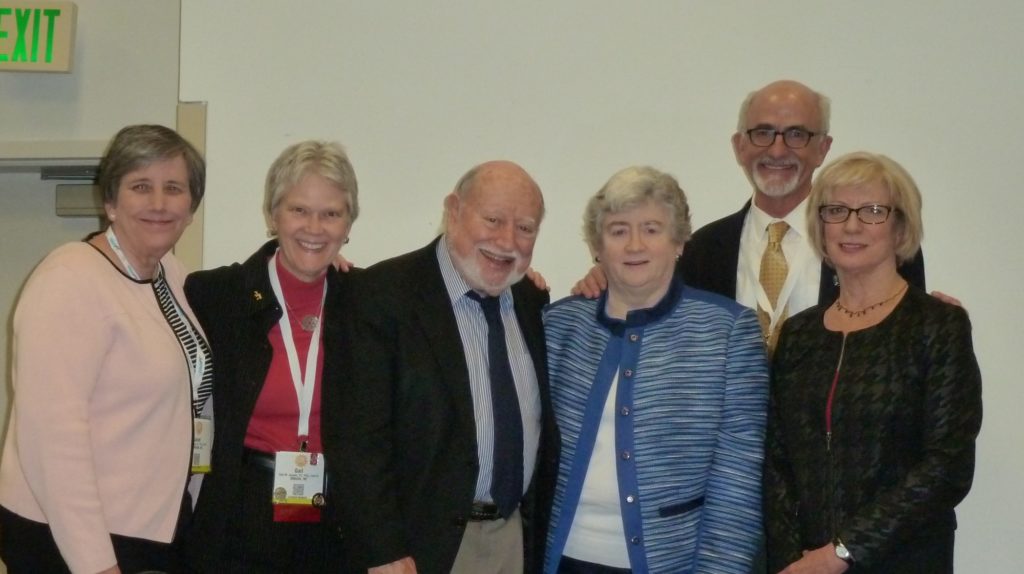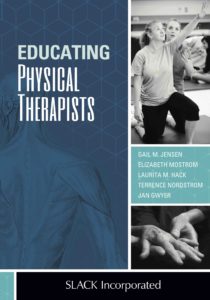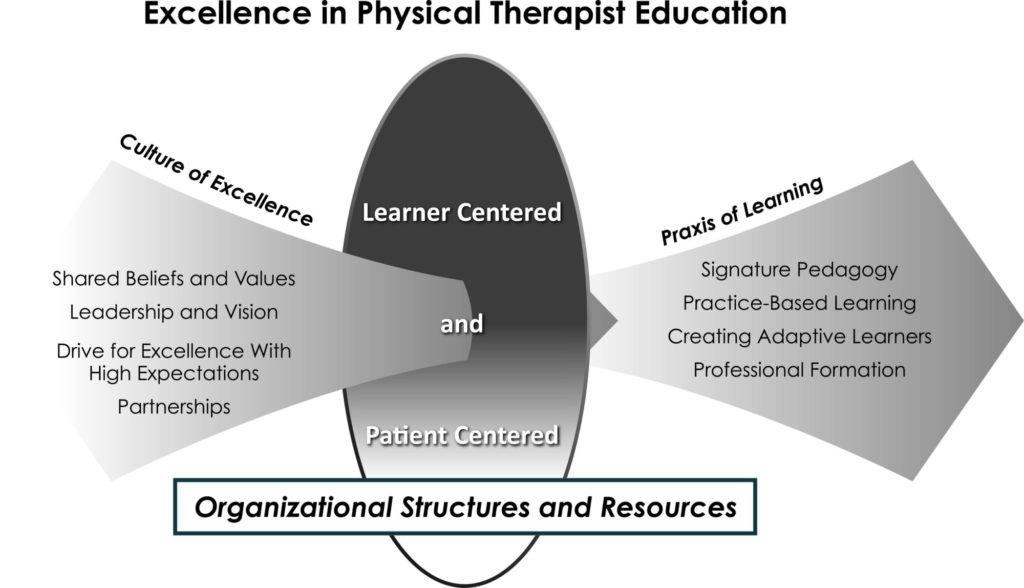Exploring Excellence: Author Reflections on Educating Physical Therapists
By Elizabeth Mostrom, PhD, PT, FAPTA; Gail M. Jensen, PT, PhD, FAPTA; Laurita M. Hack, PT, DPT, PhD, MBA, FAPTA; Terrence Nordstrom, PT, EdD, FAPTA; and Jan Gwyer, PT, PhD
In this essay, Drs. Mostrom, Jensen, Hack, Nordstrom, and Gwyer share their reflections on their decade-long investigative inquiry into excellence and innovation in physical therapist education in the United States—which culminated in their groundbreaking book, Educating Physical Therapists. The project was born out of the recognition that the profession of physical therapy, and the healthcare system in which physical therapists practice, have undergone significant change over the half century since the previous comprehensive national study of physical therapist education occurred.
The authors, respectful of the challenge to replicate the valuable work found in the Carnegie Foundation’s Preparation for the Professions Program, set out on what they describe as “an invigorating and inspiring journey” that took them coast to coast over a 10-year quest. In the book, they engage the reader immediately with their excitement at the opportunity to review state-of-the-art instructional programs and clinical sites, leading to an in-depth analysis of where PT education is headed in the future. They confirm that PT education is shared by engaged participants in the academic and clinical settings, with a focus on students and patients as the “nexus” of the educational endeavor.
Of particular interest to JHR readers are the many examples of excellent teaching and effective learning identified in the book—with a caveat. The authors also share their disappointment that PT education often may not adequately prepare students to manage the challenges of balancing intellectual knowledge, technical skills, and moral challenges in practice. They found PT education generally lacking in the successful development of a professional identity that goes beyond rituals or experiences, such as professionalism ceremonies that are not further developed into “a recurrent curricular emphasis on teaching moral professional purpose and commitment.” They point out that journals such as JHR have “much to offer the profession” in integrating the humanities across the curriculum.
In Part 3 of the book, the authors offer 30 recommendations that they believe “have the potential to transform physical therapist education.” They clearly provide direction to individual educators for changes that can be made beginning today.
Effective change needs to happen with a system-wide perspective involving multiple stakeholders. To that end, the authors strongly support the integration of the humanities into PT education as a way in which to cultivate and develop “adaptive learners”—PT clinicians who can raise the level of care and promote safe and effective PT practice in our 21st-century healthcare system.
Readers of Educating Physical Therapists are invited by the authors to share the experiences and insights that evolved during this study and to use what they have gleaned to promote excellence in the academic and clinical settings—where not only future physical therapists, but all rehabilitation professionals, are educated. We are grateful to the authors, all leaders in education, for their vision, their passion, and their outstanding commitment to the excellence in education that results in excellence in care.
—Nancy Kirsch, PT, DPT, PhD, FAPTA

Research team with Dr. Lee Shulman, Charles E. Ducommon Professor of Education Emeritus, Stanford University; President Emeritus, The Carnegie Foundation for the Advancement of Teaching

Educating Physical Therapists. Thorofare, NJ: Slack Inc.; 2019.
Most journeys begin with a destination in mind but uncertainty about the exact route to be traveled along the way. So it was with our 10-year journey to investigate excellence and innovation in physical therapist education in the United States.
Our reasons for embarking on this project were many, but chief among them was the need for a comprehensive, systematic, nationwide study of physical therapist education in the United States. Such an investigation had not taken place for almost half a century. During that same time, however, there were constant and often dramatic changes occurring in the healthcare system, the nature of healthcare delivery and practice, and higher education. All of these shifts meant that the educational preparation of health professionals needed to be examined and evolve to meet new demands and expanding societal expectations for the health professions and future professionals.
In considering our route, we were fortunate to have the wisdom and example of an undertaking initiated in the 2000s by the Carnegie Foundation for the Advancement of Teaching, which funded and conducted a series of comparative studies of professional education. The impetus for these studies grew out of the scholarship and influential work of philosopher William Sullivan, author of Work and Integrity: The Crisis and Promise of Professionalism in America,1 and the vision and leadership of Dr. Lee Shulman, then President of the Carnegie Foundation. The foundation’s Preparation for the Professions Program (PPP) led to a landmark set of comprehensive studies of professional education that, in the words of Dr. Shulman, aimed to “…demonstrate how the professionals, on whom we all depend for so much of the quality of our lives, can learn to balance…technical, intellectual and moral equations. That’s what professions do.”2(p.xv) In contrast to the well-known Carnegie-sponsored Flexner study of medical education that found tremendous variation in quality and rigor across schools, Shulman’s vision was to focus on excellence and innovation, and on uncovering new understandings of how people learn. Ambulando discimus (we learn by “going about”) remained the hallmark of these studies as research teams visited exemplars of excellence in each of their fields.
The PPP resulted in 5 far-reaching investigations of preparation for the professions of the clergy, law, engineering, nursing, and medicine; concurrently, they afforded an opportunity for a cross-professions examination of education in those fields and others. Each of the studies culminated in the publication of a book describing the study findings and outlining recommendations for reform that emanated from those findings.3-8 Today, the PPP findings and recommendations are having a significant influence on the evolution of professional education in each of the disciplines studied.
Our Methodology
Following in the footsteps of this landmark set of studies was a tall order. However, the signposts they had erected provided a source of inspiration and perseverance as we sought funding to conduct a similar study of physical therapist education, and as we began our investigative journey. Indeed, the Carnegie studies provided a roadmap for what was to come, and paved the way for our study. Like the PPP studies, we too “learned by going about” as we closely examined excellence and innovation in professional PT education. We studied participants across the continuum—from the initial preparation for entry into the profession through post-professional residency education in both academic and clinical settings.
Collectively, we brought to the endeavor more than 150 years of experience in physical therapist education, expertise in educational research and qualitative inquiry, and a deep belief in the need for and purpose of our study. Finally, we brought an abiding hope that the findings from our study would engender the kinds of deliberative reflection, rich conversation, and thoughtful reform that had resulted from the PPP studies, and that would promise a bright future for physical therapist education well into the 21st century.
After two national calls for nominations, our final sample for the study was selected and our course was charted—one that would take us on an invigorating and inspiring journey to both coasts and other regions in between, visiting 11 sites (6 academic and 5 clinical) that were identified as exemplars of excellence and innovation in physical therapist education.
Our Results
Our book, Educating Physical Therapists, is the culmination of our 10-year journey. It is divided into 4 main parts that trace our steps from its initial conception to publication.
Part 1 of Educating Physical Therapists sets the scene for what is to come. We frame our work in the historical context of physical therapy’s emergence as a healthcare profession in the 20th century, the changing nature of the healthcare field and its professional education at the same time, and the recent Carnegie Foundation studies of professional preparation.
In Part 2, we describe our research design and methods and, importantly, our evolving conceptual frameworks over the course of the study. The end result of that evolution is a final conceptual model of Excellence in Physical Therapist Education that serves as a framework for the presentation of our findings and synthesis of those findings in the remaining chapters in this part. The model highlights dimensions of excellence and their component elements, which we identified across both academic and clinical sites. The dimensions are the:
- Culture of Excellence, composed of the elements of shared beliefs and values, distributed leadership and vision, a drive for excellence with high expectations, and academic/clinical partnerships
- Praxis of Learning, composed of the elements of a signature pedagogy, practice-based learning, creating adaptive learners, and professional formation
- Organizational Structures and Resources—the foundational dimension
At the center of the model and essential to all the dimensions is a Nexus, a metaphoric lens, where the paired and highly valued aims of learner- and patient-centering in the educational enterprise come together.
 Participant Engagement
Participant Engagement
As we present the study findings in the chapters in Part 2, we hope readers will sense our thrill of engagement with participants at each site; each visit was truly enlightening and energizing. To that end, we provide substantial grounded data drawn from observations and interviews to give voice to our participants. In addition, we constructed paradigm cases meant to serve as illustrative vignettes of—or stories about—the model dimensions and/or elements “in action” so that readers might better see, hear, and feel what we had the privilege of experiencing directly as we visited participating sites and interacted with numerous academic and clinical faculty, students, residents, and administrators.
A Humanities Component
Of particular interest to JHR readers will be our findings about the Praxis of Learning. We observed many examples of excellent teaching and learning practices, yet we found less understanding of underlying learning theory and concepts central to facilitating robust learning—and to creating life-long learners. Similar to the Carnegie studies, we also found that there was a strong and visible focus on developing professional identity as experienced through rituals such as white coat ceremonies, among others. The intentional development of professional formation, however—which requires stronger and recurrent curricular emphasis on teaching for moral professional purpose and commitment—was lacking. This is where integration of the humanities across the curriculum and the role of a journal such as this one has much to offer the profession.
Our Recommendations
Like the Carnegie PPP studies before us, our findings, while identifying and celebrating markers of excellence, also allowed us to see areas for improvement; this led to the formulation of 30 recommendations that we suggest have the potential to transform physical therapist education in the future.
Part 3 of Educating Physical Therapists presents our 30 recommendations, delving more deeply into the meaning and implications of our findings, considering them in light of literature and evidence from other health professions and disciplines, to offer an expanded perspective on how to facilitate and accelerate positive change as we move forward into the 21st century. Each of the chapters in this part shines a light on one of the 3 major dimensions in the model and links the recommendations to those dimensions and the elements that comprise them.
A JHR Resonance
We believe that JHR readers will find that many of these recommendations resonate with your own concerns about and commitments to improving the preparation of rehabilitation professionals. As forecast earlier, recommendations related to professional formation and strengthening learners’ understanding of and ability to enact our social contract, will be of particular interest to readers of this journal. We see the integration of the humanities into professional education as an essential component for preparing adaptive learners who can navigate uncertain situations in complex systems, act as advocates and moral agents, and demonstrate the moral courage to address societal needs, call out and seek to change substandard practice, and meet our professional obligations.
Insights From Invited Authors
In Part 4 of the book, we attempt to answer the question, “Where do we go from here?” by crafting visions for the future, sharing the voices and perspectives of a group of distinguished invited authors. Drs. Ruth Purtilo and Patricia Benner offer insights on educating for professional responsibility and integrating the habits of head, heart, and hand in professional education. Dr. Scott Reeves and colleagues highlight the need to understand and embrace interprofessional education. Dr. Joy Higgs stresses the centrality of practice-based education for realizing excellence and future-oriented practice. Drs. Stephen Loftus and Kathryn Huggett explore directions for education research in the health professions. Drs. Steven Chesbro and William Boissonnault identify opportunities for professional education from the perspective of a health profession’s organization (APTA). Finally, we end Part 4 with our own vision – “a reimagining” of the profession, professional curricula, and the educational enterprise for the 21st century.
Collective Innovation
Our investigative and reflective journey during the completion of this study was one of constant learning and development over the years enriched by the experiences and insights shared by study participants, consultants, and audience members who asked thought-provoking questions as we presented emerging findings as the study unfolded. Through this book we invite readers to join us on that journey and hope that as you retrace our steps, you will be inspired to envision alternative paths and forge new trails that will advance excellence and innovation in education not only for physical therapists but for all rehabilitation professionals.

From left: Gail M. Jensen, Terrence Nordstrom, Jan Gwyer, Laurita M. Hack, Elizabeth Mostrom
References
- Sullivan WM. Work and Integrity: The Crisis and Promise of Professionalism in America. 2nd San Francisco, CA: Jossey-Bass; 2005.
- Shulman LS. Preface. In: Sullivan WM. Work and Integrity: The Crisis and Promise of Professionalism in America. 2nd San Francisco, CA: Jossey-Bass; 2005: xv.
- Cooke M, Irby D, O’Brien B. Educating Physicians: A Call for Reform of Medical School and Residency. San Francisco, CA: Jossey-Bass; 2010.
- Benner P, Sutphen M, Leonard C, Day L. Educating Nurses: A Call for Radical Transformation. San Francisco, CA: Jossey-Bass; 2010.
- Sheppard S, Macatangay K, Colby A, Sullivan W. Educating Engineers: Designing the Future of the Field. San Francisco, CA: Jossey-Bass; 2009.
- Sullivan WS, Colby A, Wegner JW, Bond L, Shulman L. Educating Lawyers: Preparation for the Profession of Law. San Francisco, CA: Jossey-Bass; 2007.
- Foster C, Dahill L, Golemon L, Tolentino BW. Educating Clergy: Teaching Practices and Pastoral Imagination. San Francisco, CA: Jossey-Bass; 2006.
- Colby A, Sullivan W. Formation of professionalism and purpose: perspectives from the preparation for the professions program. U St. Thomas Law J. 5:404-427, 2008.


 Ted Kooser is a prolific poet, devoted to engaging a broad audience for poetry through his own creative work and the weekly newspaper column he edited, American Life in Poetry. The column was carried in more than 150 newspapers. Ted Kooser was named the United States Poet Laureate Consultant in Poetry in 2004 and was reappointed in 2005. He lives on an acreage 3 miles outside the village of Garland, Nebraska—not far from Omaha, where I reside. His poetry collections and non-fiction often include finely-crafted observations about his home state, the landscape, and the people who reside there.1 Over the past several years, I have enjoyed hearing him read his work at public events, have visited with him and his wife Kathleen over dinner at the home of mutual friends, and have corresponded with him. We share an interest in writing creatively about personal illness, as both of us lived through diagnosis and treatment of cancer. His illness and recovery led to a poetry collection that is a departure from themes that generally are the focus of his work.
Ted Kooser is a prolific poet, devoted to engaging a broad audience for poetry through his own creative work and the weekly newspaper column he edited, American Life in Poetry. The column was carried in more than 150 newspapers. Ted Kooser was named the United States Poet Laureate Consultant in Poetry in 2004 and was reappointed in 2005. He lives on an acreage 3 miles outside the village of Garland, Nebraska—not far from Omaha, where I reside. His poetry collections and non-fiction often include finely-crafted observations about his home state, the landscape, and the people who reside there.1 Over the past several years, I have enjoyed hearing him read his work at public events, have visited with him and his wife Kathleen over dinner at the home of mutual friends, and have corresponded with him. We share an interest in writing creatively about personal illness, as both of us lived through diagnosis and treatment of cancer. His illness and recovery led to a poetry collection that is a departure from themes that generally are the focus of his work.
 Member since 2019 | JM14274
Member since 2019 | JM14274


NO COMMENT